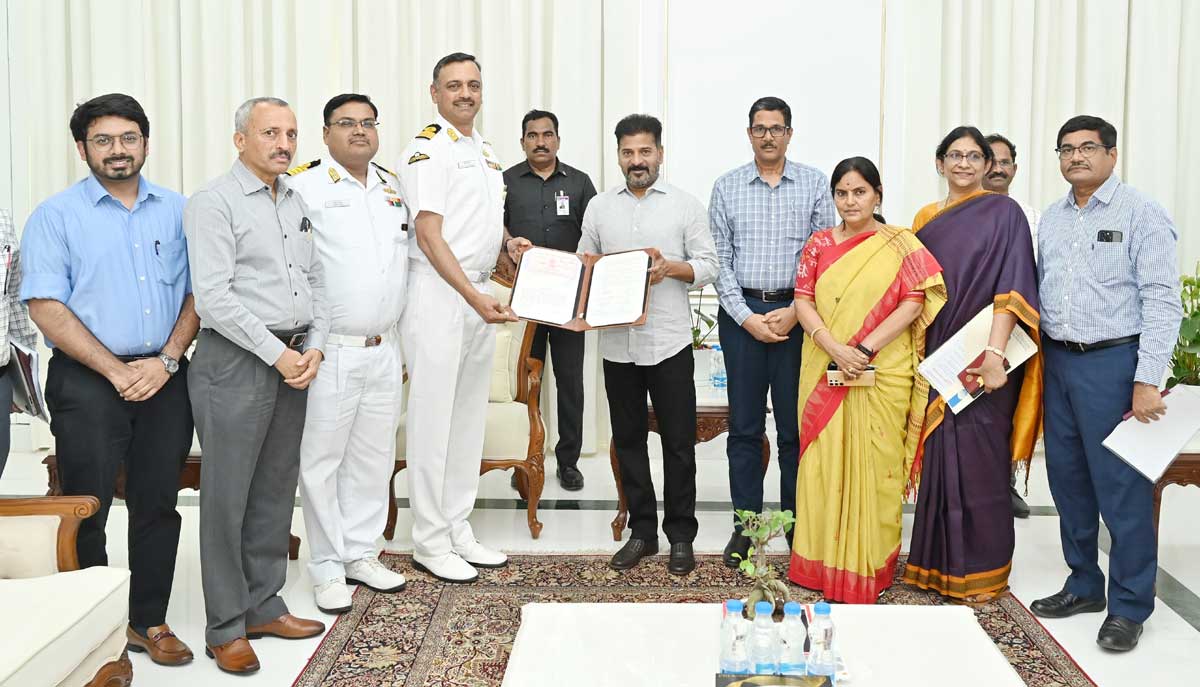Very Low Frequency (VLF) is a radio frequency band in the range of 3 to 30 kHz with wavelengths from 10 to 100km. It has a limited bandwidth and is mostly only used for coded signals with low data rate such as underwater communication.
Updated On – 2 February 2024, 06:19 PM

Team of Naval Officers receive the letter from CM Revanth Reddy and Chief Secretary A. Shanti Kumari to up the VLF Communication Station in Vikarabad district.
Hyderabad: The Indian Navy has recently chosen Vikarabad district in Telangana to set up its second Very Low Frequency (VLF) Communication Transmission Station in the country.
Ever since the news broke out, there have been discussion over it, especially after environmentalists vehemently opposed the decision of setting up the centre in a 2900 acre pocket of land in Damugundam Forest Reserve in Pudur mandal of the district.
What does Very Low Frequency (VLF) mean?
Very Low Frequency (VLF) is a radio frequency band in the range of 3 to 30 kHz with wavelengths from 10 to 100km. It has a limited bandwidth and is mostly only used for coded signals with low data rate such as underwater communication.
This frequency has large wavelengths which allow them to penetrate salt water after diffracting around huge obstacles and propagating as ground waves along the earth’s curvature. This capability of the VLF is why it has been a popular choice of militaries across the world for communication with submarines.
How are they useful?
VLF waves are of great use as they can penetrate seawater to just over 30 meters and submarines at shallow depths can use them, as some navies use powerful shore VLF transmitters for submarine communications. Vessels that are deeper inside the water use bouys equipped with antennas.
India, Russia, Norway, Pakistan, United Kingdom, United States, Germany and Australia are the only few nations that use the VLF facilities for communicating with their submarines.
What is the controversy surrounding the Communication Station being set up in Telangana?
Worried over the adverse impact on ecosystem and biodiversity, environmentalists and climate change experts are opposing the State government’s decision to allocate Damagundem forest lands for setting up Navy’s VLF station at Pudur village in Vikarabad.
The experts are demanding that the government review its decision and convene a meeting with all sections to discuss the project’s impact.
According to experts, the contention is not just about alienation of lands but it is also about the impact on air quality, loss of invaluable medicinal plants, diversified fertile soils and flood threat to the twin reservoirs of Himayath Sagar and Osman Sagar, water and climate change
What does the Indian Navy have to say?
In response to the brewing controversy, Capt Sandip Das addressed the media and shared some information about the upcoming VLF Communication Station at Vikarabad.
In his address, Capt Sandip Das said that the Indian Navy understands the misgivings of the local population and assured that no ill-effects, either in humans or on the flora and fauna have been observed in and around the first such Communication Station in India, INS Kattabomman in Tirunelveli, which has been operational since 1990.
“There are around 800 personnel including from the Navy DCS, MES and civilian staff who are working inside the station at any given point of time. In addition, there are about 1200 family members who reside inside the station,” said Capt Sandip Das.
Assuring the environmental safety, he stated that an Environmental Impact Assessment has been carried out by an independent agency and cleared by an Expert Appraisal Committee under the MoEF and that the Indian Navy has only subsequently gone for Stage I and Stage II clearances from the MoEF.
“We have met the 16 point compliance based on which the clearance was given for the project. This compliance is very strict and can be monitored by the Forest Department at any time,” he added.


